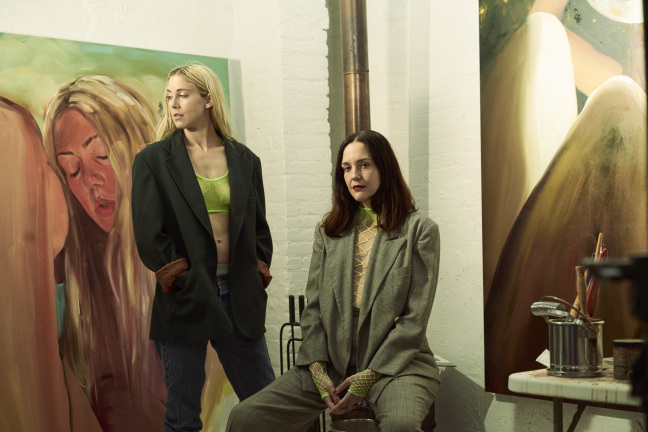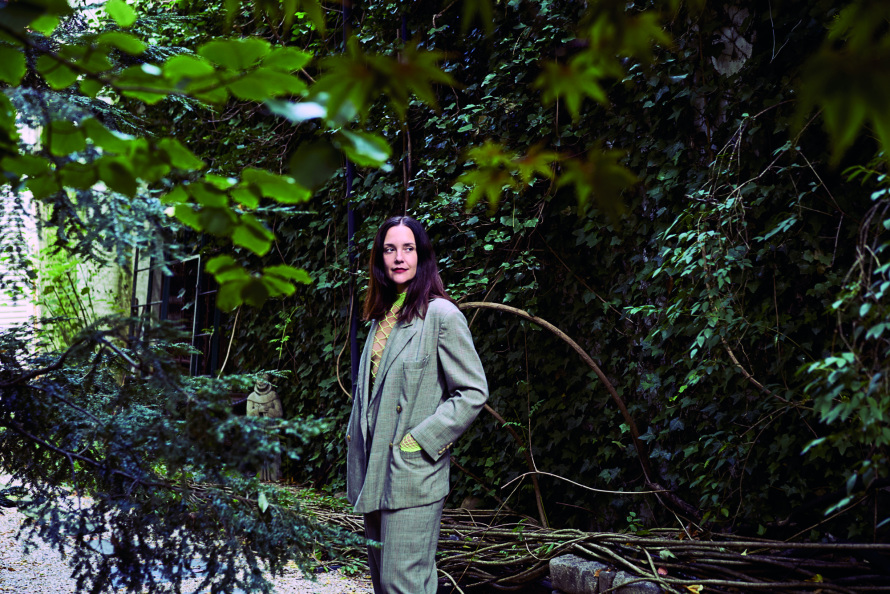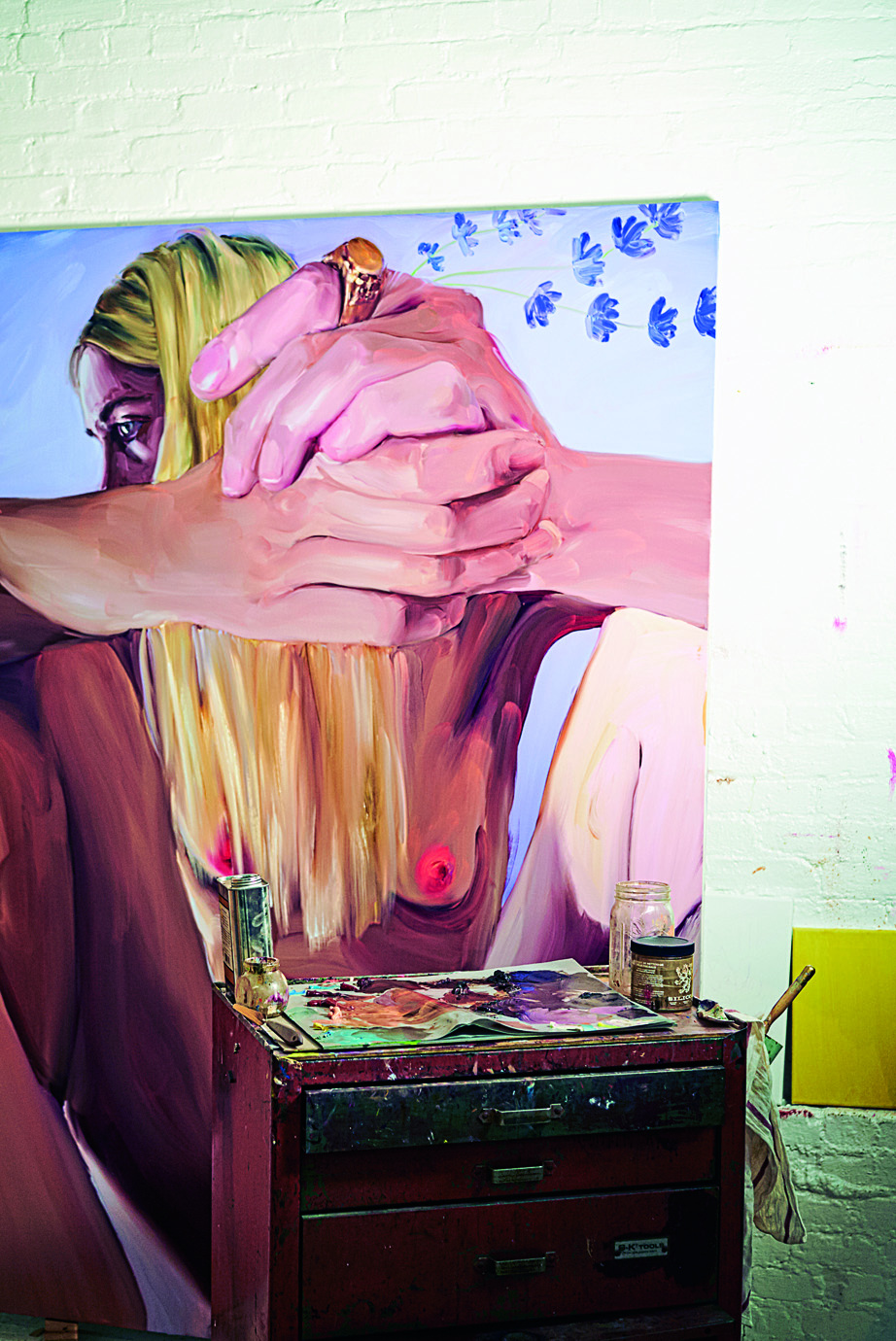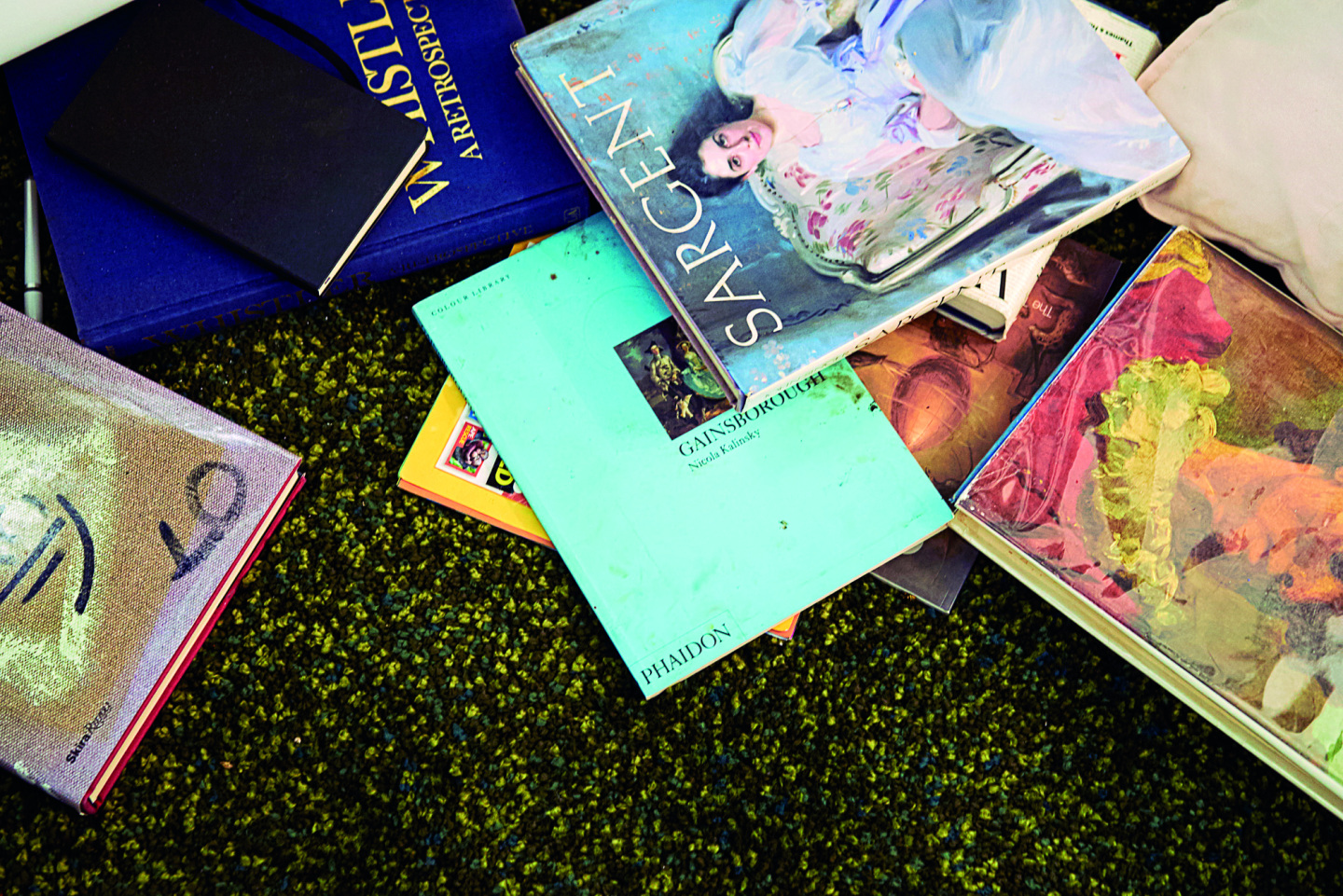“A reluctance to be painted was something I was really trying to get into the work,” Jenna Gribbon tells me. We are sitting on a leafy rooftop in Brooklyn overlooking her skylighted studio where the artist has been focused on portraits big and small of her lover, musician Mackenzie Scott. Gribbon shares that recently her desire to capture reticence has manifested in the form of a favorite prop: the clamp light. In the largest, most lubricious works in the studio bound for a January 2022 solo show with MASSIMODECARLO in London, her girlfriend is depicted blinding herself in an almost cop-like interrogation. In others, Scott turns the bulb on Gribbon, and then on us. Now we are the suspects. This follows on the heels of recent paintings like Comment Section (2021), in which the musician holds up her fingers as a temporary shelter, Kanye in his shutter shades. “Comment sections are crazy and when they’re about you, they’re even crazier,” Gribbon says. “It’s that thing of being seen, your image being consumed and then having to deal with every person’s thoughts about who you are or what you’ve said or what you’ve done.” Scott, who performs as Torres, the indie rock star, makes a rich subject for inquiries into how our images are constructed and distributed with and without our blessings. “I’m always interested in the way that people are seen versus the way that they think they are or the way they want to be,” Gribbon says. “Because my partner is a public figure, it ends up also being about public versus private, how she’s depicted outside of our home versus inside of our home and what those two things look like next to each other.”

Scott shares Gribbon’s fascination with Zen and the art of image maintenance. “We are co-conspirators,” Scott diagnoses a few days later, on a group FaceTime. “When you have a romantic relationship with an artist of any kind, you’re signing up for exhibitionism at the mildest and, at the most extreme, maybe exploitation.” A reflexive pause. “I would like to think the tail is not wagging the dog. The relationship is what informs our art. There’s probably crosspollution but that’s the most fun thing about the relationship and the work.”
“Uscapes,” Gribbon’s fall 2021 exhibition at Fredericks & Freiser in New York, was composed of a suite of small nudes, mostly of Scott’s ass, paintings which you had to almost get inside of to see clearly. In these works, Gribbon’s culpability is acutely framed, sometimes as a camerawoman taking quiet advantageous footage, sometimes as an outright villain pushing the limits of consent. Scott is rarely pictured smiling but rather betrayed in various shades of discomfort, from suspicion to contempt. The lovers’ rapport isn’t idealized by Gribbon’s brushstrokes, but rather worked through in the medium’s crude terms, arms and thighs carved out with the same winding licks. Big patches of careful color are devoted to knees, which rise like mountains to screen Scott’s expressions. We are as close as we can get but her calves are still in the way. The canvas creates our frame, and then Scott’s legs cut it into unequal halves— channeling our sight lines. These are the joint decisions that make them co-conspirators. With her posture, Scott demands a break—a cigarette off-screen. A painting of Scott captured through a slit in the bathroom doorway titled Small Crack (2021), shows her form bent over examining her chin (zits, perhaps?) in a mirror. Her body is not composed for us but instead doubled over in earnest examination. It’s the opposite of Balthus’s Nude Before a Mirror (1955). We are still the voyeur but here Scott, like us, is an accomplice in judgement—picking at her body in the same way the viewer inspects the paintings. I feel a blush of shame for us all.

In writing about Gribbon’s work, I set out to avoid the generally mawkish conversation around figuration in contemporary paintings— the ones that dawdle on the erotic (which Gribbon seems to initiate in most paintings depicting Scott nude, but ultimately dodges by giving her neon pink nipples), the ones that gawk at frenzied markets and auction highs, the ones that overuse the word “intimacy” while flattening love and painting into LGBTQ thought. I wanted to explore inclusion and agency within the context of romance and art, which use public and private platforms to survive—just like the market and pornography and politics.
Gribbon’s film-world hero, Agnès Varda (to whom she dedicated an entire exhibition in 2021), offered a way in. The last beat of Varda’s cinematic love letter to Los Angeles, Lions Love (…and Lies) (1969), is given to Warhol Factory darling Viva (aka actor Janet Susan Mary Hoffmann). Viva’s wish is to spend her time silently looking into the camera: “I’m so sick of doing monologues, I would like to just breathe for one minute,” she announces. Rather than ignore the victims of her sharp autofictions, Varda provided an avenue for friends, peers and strangers to air out their grievances. Viva is permitted to be tired of the camera and Varda’s direction.



The French director’s diary mingled so frequently with her plotlines that the collateral emotional damage became a structural concern of the work, just as it is in Gribbon’s. Varda’s solution was to implicate herself in the hardships of being candid—by placing herself never too far from the frame even when she was technically invisible. Gribbon’s images of her lover and other select subjects function in the same charmingly self-sabotaging way, aligning the artist with memoirists like Varda but also Chris Kraus, Hannah Wilke, Nan Goldin, Diamond Stingily, Alice Neel.
I’m mad at Neel lately. (I carry my admiration for historic figures out like little affairs.) Neel’s recent Metropolitan Museum of Art retrospective, ironically titled “People Come First,” made the painter’s resentfulness of others so unbearably two-dimensional that I haven’t been able to enjoy the paintings ever since. What I like about Gribbon’s work, which deals in the same familiarity, is how it spreads any loathing, self- or otherwise, equally over viewer, maker and subject. I am at once curious and guilty. Try not feeling like a perv observing one of her canvases too close in a public space.
But what exactly is the comeuppance for turning your relationships into art? Gribbon says she finds herself needing to set internal reminders to turn off painter’s brain and “live in the moment” and that the trepidation in Scott’s painted eyes is real. She also acknowledges that her son, who occasionally appears in the work, flinches whenever the iPhone, her preferred camera, comes out. The caveat is that he enjoys seeing himself once the paint dries. I suggest that perhaps this is because he can sense the love demonstrated in the labor, the same labor photography obscures in its haste. Gribbon nods, but then tempers it with her motivations. She says painting is precisely the space to engage our impulse to resist and that in some way it is the reflexive recoil that she feels compelled to document. “We assume people want to be seen but is that true?” Gribbon asks. “We’ve only been documenting, composing ourselves in obsessive ways for less than a century. I’m interested in investigating that assumption and what the costs are for those who are represented.”
A surprising upshot of their relationship’s entanglement with Gribbon’s work is that the paintings occasionally provide a counterintuitive privacy. Scott is such an idiosyncratic fixture of the work that the art world sometimes addresses her in the shorthand of plusones. “Some people don’t even know I’m a musician. I’m just Jenna’s girlfriend,” Scott laughs. “Jenna is a star and I love that it gives me this place to burrow and get to watch for once. I’m such an exhibitionist because of what I do but with Jenna, she’s on display just as much as her subjects are because she has such a strong point of view.” Gribbon’s take is so invested in how all readings and facets of a figure could potentially occupy the same canvas that every new perspective it touches is subsumed into its own logic. Your world becomes a part of hers but it’s an exchange of information, not a surrender. “Painting is a way of understanding an image down to its minutiae,” Gribbon says. “It’s a way to have a relationship to every inch.”










 in your life?
in your life?

